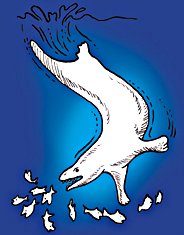This fossil material was found in fluvial red sediments, or river-produced deposits colored by material leached from iron ores. This formation is thus a terrestrial or continental deposit. The fossil remains associated with Pakicetus is dominated by land mammals. Nonmammalian remains include other terrestrial remains such as snails, fishes (particularly catfish), turtles, and crocodiles. This evidence indicates a fluvial and continental rather than a marine environment as would be expected for a whale or whale-like creature.
The authors state that the basicranium (only the back portion of the cranium was found) is unequivocally that of a primitive cetacean. On the basis of the brief description given in the article (eight lines of the text) one has no way of knowing whether that is true other than the declaration by the authors. It seems highly significant in that respect, however, that the auditory mechanism of Pakicetus was that of a land mammal rather than that of a whale, since there is no evidence that it could hear directionally under water nor is there any evidence of vascularization of the middle ear to maintain pressure during diving.
The teeth of Pakicetus are said by the authors to resemble those of terrestrial mesonychid Condylarthra and also to be similar to teeth of middle Eocene archeocete Cetacea such as Protocetus and Indocetus. Mesonychids are thought to be terrestrial mammals that were hoofed and possibly fed on carrion, mollusks, or tough vegetable matter.7 The authors mention two other "primitive cetaceans," Gandakasia and Ichthyolestes, known only from teeth, as being found in the same formation with Pakicetus. These have been described by West,8 and had earlier been identified as land mammals (specifically mesonychids). West, however, reassigned them to the order Cetacea.
Not a single fragment of the postcranial skeleton of these creatures has been found, so we have no idea what they really looked like. The fact that their remains were found in a terrestrial fluvial deposit with fossils of many other land animals, their teeth were very similar to known land animals, and their auditory mechanism was obviously not that of a whale, would seem to indicate, to say the very least, that the claim that a missing link between whales and land mammals has been found is premature. We are reminded of the admission of Professor Derek Ager (no friend of creationists) that practically every evolutionary story he had learned as a student has now been debunked.9 We suggest that Pakicetus will eventually join the ranks of the debunked "missing links" which include Trueman's Ostrea/Gryphea, Carruther's Zaphrentis, Piltdown Man, Nebraska Man, Neanderthal Man, and the hominoid collarbone recently identified as a dolphin rib.10
http://www.icr.org/article/creating-missing-link-tale-about-whale/


